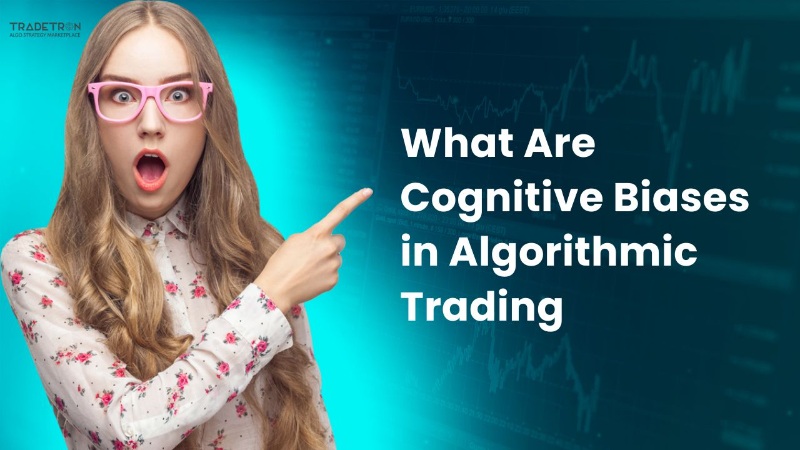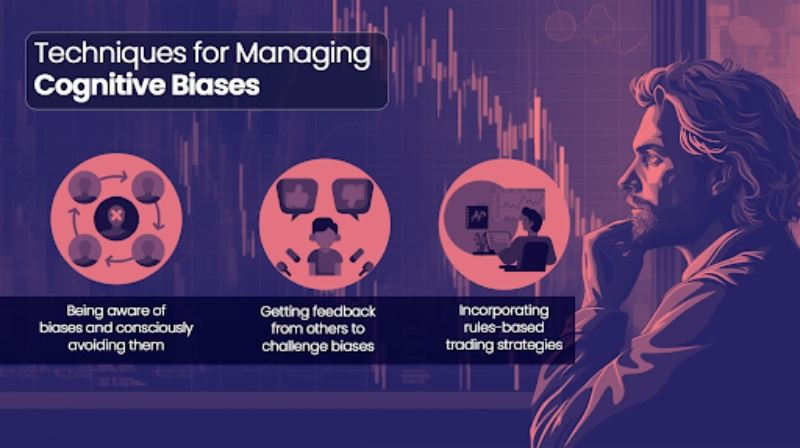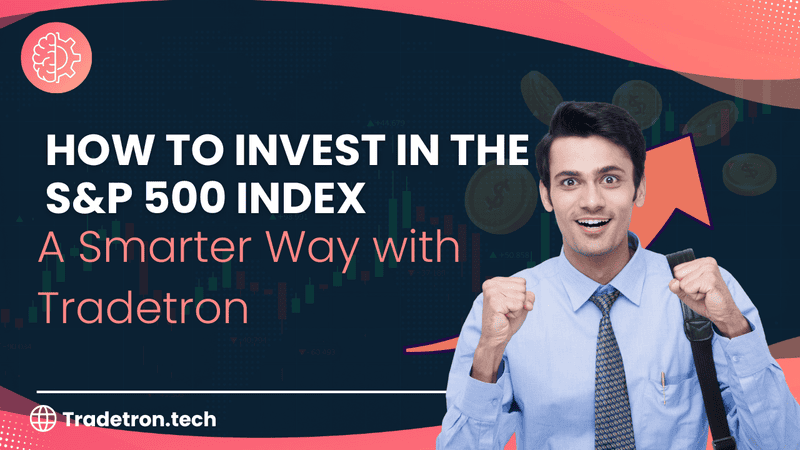Contents
- What are Cognitive Biases?
- Understanding Cognitive Biases in Algo Trading
- Types of Cognitive Biases in Algo Trading
- Techniques for Managing Cognitive Biases
- Being aware of biases and consciously avoiding them
- Getting feedback from others to challenge biases
- Incorporating rules-based trading strategies
- Final Thoughts and Recommendations
- Overcome Your Biases and Trade With Tradetron
Trading psychology plays a giant role in determining algo trading outcomes.
You’d think nothing could be more cold and calculating than having algorithms execute buy and sell decisions.
Yet, every algorithm has human origins and is influenced, at least in part, by the prejudices and preferences of its creators.
That’s not to say the human component in algo trading is all bad. It is only certain irrational aspects of our decision-making that can potentially upend the effectiveness of an otherwise perfect algo-trading strategy.
That’s why it’s not unusual for even the most experienced algo traders to occasionally misread market trends, act on emotions, and incur losses.
Read on to find out how a better understanding of cognitive biases can help you avoid such eventualities.
What are Cognitive Biases?

A cognitive bias is a glitch in human thought processing. These biases come into play whenever we allow our judgement and responses to be guided by subjective feelings, beliefs, or experiences.
Think of them as an automatic filter engaged by the brain to oversimplify information in line with our assumptions and preferences.
Here are a few everyday examples of cognitive bias that many of us may be subject to:
Assuming someone’s gender based on their profession. For instance, to think of all nurses as being female and all fighter pilots as being male.
Attributing qualities based on age. For instance, thinking all senior citizens are out of touch, or children cannot be trusted with tools.
Stereotyping based on outward appearance. For instance, considering the most smartly dressed real estate agent to be the most trustworthy.
Cognitive biases can be innocuous and seem perfectly rational until they are put to the test.
They are benign in most cases and often ignored because we see many others thinking or acting the same way.
That’s not the case, however, in an algo trading environment, where cognitive biases can lead to major negative impacts.
Understanding Cognitive Biases in Algo Trading
Investing is a decision-intensive practice. Because we can be guided to a large extent by our personal beliefs and value systems, there’s a fair chance of having cognitive biases influence our algo trading decisions as well.
It wouldn’t be wrong to say trading in general, and algo trading in particular, are uniquely susceptible to cognitive biases.
Traders are driven by their own set of expectations, beliefs, fears, and other psychological traits.
That can lead them to manipulate expectations, make flawed interpretations of trends, and force negative outcomes.
It’s crucial, therefore, to make a conscious distinction between being insight-driven and being cognitively biased.
Types of Cognitive Biases in Algo Trading
Cognitive bias is an umbrella term used to cover a wide range of psychological phenomena.
Let’s understand the most prominent types of cognitive bias so you can be aware of them and exclude them from your trading decisions.
Confirmation Bias
It refers to seeking out information that confirms pre-existing beliefs and ignoring information that points to the contrary.
Confirmation biases are self-reinforcing because they tend to strengthen themselves with each instance.
To use an example, a trader who prizes the shares of a particular company may ignore negative information about that company.
Research shows that, given the choice, traders are more likely to read a news article that supports an investment decision they’ve made rather than one that opposes it.
Overconfidence Bias
This is a type of cognitive bias that seasoned traders are often more prone to.
It is defined as the tendency to overestimate one’s skills, knowledge, and intellect in general terms or regarding a particular field.
For instance, an experienced trader who is fully aware of market conditions, stock trends, and margins can still make catastrophic decisions.
It usually happens when potential risks are sidelined because of overconfidence in one’s trading abilities.
Hindsight Bias
Hindsight bias is the false assumption we make of having predicted an occurrence or outcome the moment we learn of it.
It’s more common than you can imagine. It’s evident every time someone exclaims “I knew it!” when they hear of their chosen candidate winning an election, for instance.
One of the subsets of hindsight bias is what’s known as ‘Monday morning quarterbacking’: the tendency to presume not only foreseeing the outcome of a game but also how that outcome could have been changed.
As you can see, hindsight bias is particularly relevant in the volatile and unpredictable world of algo trading.
Availability Bias
People with availability bias tend to favor the most readily available information when evaluating a situation or making a decision.
It can manifest in various ways.
For instance, when deciding between two brands of soap at the supermarket, we’re more likely to pick the one we recently saw an ad for.
Availability bias is best described as the tendency to make decisions based on easily-recalled past experiences.
Anchoring Bias
Remember believing as a child that whoever went to their parents first with a complaint about their sibling tends to be believed.
You were right! It’s human tendency to believe anyone who pleads his case first.
That’s because anchoring bias causes us to rely overly on the first piece of information we come across in any given situation.
That first bit of information becomes an anchor around which we arrange all subsequent information.

Techniques for Managing Cognitive Biases
Despite their constant presence, managing cognitive biases is not as difficult as it may sound.
The best way to deal with them is to limit fast thinking
- which relies on mental shortcuts, in favor of slow thinking
- which gives you time to reason and evaluate.
Here are a few effective practices to help you override cognitive biases in trading environments:
Being aware of biases and consciously avoiding them
Being self-aware is one of the easiest ways to eliminate cognitive biases.
Knowing your innate tendencies and predispositions is the first step toward overcoming them.
Evaluate your trading decisions objectively and identify if your biases have come into play at any stage of the decision-making process.
Doing this regularly will limit your susceptibility to cognitive biases.
Getting feedback from others to challenge biases
Biases usually negate themselves when decisions are taken in coordination and consultation with others.
Taking a colleague’s advice on whether to take a short position on a specific stock, for instance, can help you identify and rectify any biases that may have influenced your decision.
Another way of doing this is by sharing the path you took to reach a particular conclusion with a colleague and inviting their observations on your process.
Incorporating rules-based trading strategies
Rules don’t make fools! That is especially true when you’re dealing with cognitive biases in algorithmic trading.
Rules help you stay within boundaries and can help streamline your thinking process.
Be cautious of acting hurriedly upon ideas that don't follow the rules outlining your trading strategy.
Some amount of flexibility with trading rules can be worthwhile at times, but only as long as they are made with a clear and unbiased mind.
Final Thoughts and Recommendations
Investing is all about making the right decisions based on all available information.
Better-planned, better-timed, and better-executed decisions yield better profits.
Getting rid of cognitive biases is crucial for any algo trader to sustain and succeed.
Make sure to follow the techniques discussed above to make your trading decision free of cognitive and emotional biases.
Overcome Your Biases and Trade With Tradetron
Tradetron is a trading algorithm strategy marketplace that lets you create, back-test, improve, and execute trading models.
It enables the automation of quant strategies, which are then sold globally to investors and traders.
All this is achieved without the need to write any code.
Explore Tradetron today for best-in-class algorithm trading strategies.
We offer dedicated bots for each strategy for rapid execution and condition checking.
It eliminates the hassle of data linking, software downloads, and extra data charges.
Frequently Asked Questions Cognitive Biases in Algorithmic Trading
1. What is a cognitive bias in trading?
Cognitive bias in trading refers to the tendency of traders to make decisions based on subjective beliefs and opinions rather than objective data.
This can lead to irrational behavior, such as overconfidence in one's abilities or an aversion to taking risks.
Some common examples of cognitive biases in trading include Confirmation bias, where traders seek out information that supports their preexisting beliefs while ignoring evidence that contradicts them.
Hindsight bias, where traders believe they could have predicted a market event after it has already occurred.
Anchoring bias, where traders become fixated on a specific price point or range and are reluctant to deviate from it.
To avoid falling prey to cognitive biases, traders must remain disciplined and focused on objective analysis of market trends and data.
This involves regularly reviewing performance metrics, setting realistic goals based on past successes and failures, and remaining open-minded about new information that could impact their trades.
By doing so, traders can minimize the impact of cognitive biases on their decision-making processes and improve their chances for long-term success in the markets.
2. What is a trading bias?
"A trading bias refers to a trader's subjective viewpoint that influences their decision-making process."
It can be based on personal experiences, emotions, societal norms, or even past market trends.
While biases are often subconscious, they play a significant role in shaping how traders interpret information and make trades.
3. How do you overcome trading bias?
Trading bias is one of the most common pitfalls that traders encounter in their trading journey.
It is a mental obstacle that can hinder your ability to make rational and objective decisions when it comes to trading.
Overcoming trading bias requires discipline, self-awareness, and a willingness to learn from mistakes.
Here are some tips on how you can overcome trading bias:
1. Identify Your Biases: The first step in overcoming trading bias is identifying what kind of biases you have. Common biases include confirmation bias, anchoring bias, and availability heuristic.
2. Keep A Trading Journal: Keeping a journal will help you track your trades and analyze your decision-making process objectively.
3. Follow Your Plan: Develop a well-defined strategy before entering any trade, stick to it even if emotions or external factors try to sway you.
4. Take Breaks: Being glued into the charts for extended periods makes traders restless leading them down an emotional path making irrational decisions instead of being analytical with market data, taking breaks clears anxiety levels allowing focused analysis without outside pressures influencing thought processes
5. Continuously Learn And Evaluate Performance Metrics: To improve performance metrics one must continue learning by reviewing chart patterns used during previous successful trades as well as acknowledging unsuccessful ones while keeping up-to-date with current events affecting markets so adjustments can be made accordingly.
In conclusion, overcoming trading bias takes time but developing good habits such as staying organized through tracking progress with journals combined with clear strategies supported by continuous education about markets helps create clarity over time ultimately improving decision-making abilities maximizing profits within predetermined risk tolerance limits.
4. How do Cognitive Biases Affect Trading?
Cognitive biases can have a significant impact on trading decisions.
These biases are mental shortcuts that our brains take to make decisions quickly, but they often lead us astray from making rational choices.
One common cognitive bias is the confirmation bias, where traders seek out information or interpret data in a way that confirms their pre-existing beliefs about the market.
This can result in ignoring contrary evidence and holding onto losing positions for too long.
Another cognitive bias is the availability heuristic, which occurs when traders rely heavily on easily accessible and recent information to make trading decisions.
This may cause them to overlook important factors such as long-term trends or historical patterns.
Moreover, overconfidence bias occurs when traders overestimate their abilities and underestimate the risks involved with certain trades.
This can lead to excessive risk-taking and significant losses if trades do not go as expected.
Finally, anchoring bias involves being overly influenced by an initial impression or starting point when making subsequent trading decisions.
Traders may base their expectations solely on past performance without considering current market conditions or new information.
To overcome these biases, it's important for traders to remain aware of them and actively work towards counteracting them through deliberate decision-making processes based on objective analysis of all available data sources rather than relying purely upon intuition alone.



 Made with Superblog
Made with Superblog